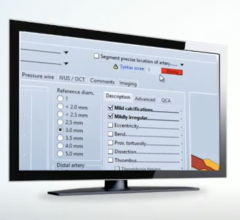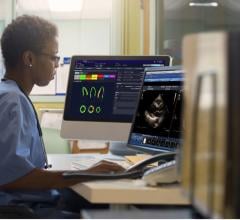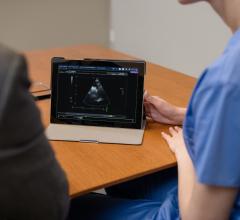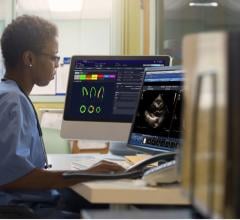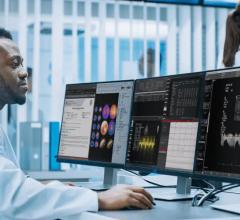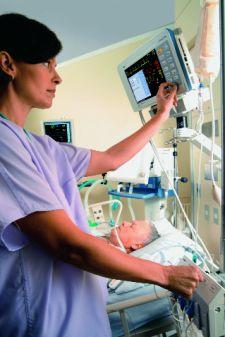
Draeger Medical provides a single patient monitor that can be used anywhere throughout the hospital.
The most “wired” cardiology departments integrate IT systems, leverage data tracking and patient monitoring solutions, optimize data and image management for improved workflow, consult evidence-based medicine and plan for future enhancements to their infrastructure. The few that meet all of these criteria serve as examples and set the curve for the rest of cardiology departments across the U.S.
The Great Integration
The growing volumes of imaging exams, such as CT, MR, PET/CT and SPECT, performed for diagnostic and cardiovascular treatments are growing exponentially and creating the demand for more robust cardiology PACS (C-PACS) capabilities. This has prompted a need for CPACS data to be integrated with nonimage patient information, such as hemodynamic monitoring, ECG and EMR patient information, contained in the cardiovascular information system (CVIS) in order to create structured reporting capabilities. Hospitals have taken action to streamline cardiology’s increasingly complex workflow by interfacing C-PACS with CVIS.
“Two thirds of the hospitals [in the U.S.] that have a C-PACS/CVIS already are planning to upgrade, replace or add new capabilities to their current systems over the next three years, to meet their evolving needs,” reported a survey by IMV’s Census Databases and Market Reports that sampled 202 department administrators who are C-PACS decision- makers, including cardiovascular services administrators, IT/MIS directors, C-PACS managers and radiology administrators in U.S. hospitals.
While many hospitals have chosen to integrate the two platforms within departmental silos, others have opted for an enterprise-wide solution. “Integration of radiology PACS with C-PACS is occurring in stages, using the building blocks of a common data archive infrastructure, common databases, workstations and/or image visualization software. However, 45 percent of the respondents that have C-PACS have not yet integrated any of these components with their existing radiology PACS,” said the report. However, “in the smaller hospitals that are adopting C-PACS/CVIS, the cardiology and radiology departments are more likely to share the responsibility for the implementation of cardiology PACS systems than in the larger institutions,” the report said.
The industry has responded through consolidation in an effort to offer C-PACS and CVIS integrated solutions. We have seen C-PACS/CVIS mergers between Philips Healthcare and Witt Biomedical, GE Healthcare’s acquisition of Dynamic Imaging, McKesson with Medcon, Agfa and Heartlab, Emageon with Camtronics and Fuji’s purchase of ProSolv.
Getting “Wired”
While implementing a C-PACS/CVIS solution marks a significant leap for most cardiology departments, Diagnostic & Interventional Cardiology (DAIC) surveyed several hospitals to determine which one’s had taken information technology (IT) adoption a step further. Those cardiology departments that employ IT solutions to address safety and quality, customer service, business processes, workforce and public health issues were the ones DAIC considers the most “wired” cardiology departments. While there are many outstanding examples of high-IT use in cardiology, DAIC selected a few that set the curve.
One of the nominees was the winner of the 2006 HIMSS Davies Ambulatory Care Award, Cardiology of Tulsa, Okla, known as COT. A a full service cardiology practice, COT offers comprehensive noninvasive diagnostic and therapeutic care ranging from disease prevention and testing, to interventional cardiology and electrophysiology. The practice has five offices in three cities, serving patients throughout northeastern Oklahoma. What is unique about COT’s story, is that as a full-service cardiology practice, which began its search to achieve its technology vision in 1989, its first implementation was not a success.
This learning organization overcame obstacles, using motivational strategies such as Project CHEARTBURN, and now defines EMR-EHR success with immediate access to patient information, improved workflow and quality of care and revenue enhancement.
Today, COT has undergone complete work and process re-engineering with full integration of an electronic health record (EHR), creating virtually a paperless environment. In fact, since its EHR implementation in 2001, COT has transitioned more than 9 million documents to the EHR and abstracted data from patient charts to populate specific fields in the electronic record to make crucial information available at a glance. With its EHR, COT’s new patient workup has been cut from 20 minutes to seven minutes, records for unscheduled patients are immediately available, information is communicated to referring physicians faster and patient education in the exam room — via electronic diagrams, immediate access to test results, angiographic video images, etc. — is more comprehensive and effective. Additionally, COT saved more than $1.1 million from 2001 to 2004, demonstrating the type of value derived from successful implementation.
Upon deciding to grow the cardiology program, COT’s referring hospital contacted their competitors and essentially reached an agreement for the competitors to place a full-time cardiologist in the community. Before the deal was finalized, COT’s referring physicians requested the hospital give COT an opportunity to submit a proposal allowing the hospital to compare offerings. COT met with the hospital, and told COT it could have the contract, but that it had to bring a physician to the community during the day every week, Monday through Friday, until they and the hospital could jointly recruit someone to live in the community. Plus, COT would need to start providing services the next week. If COT was unable to make that level of commitment, the arrangement would go to its competitors. The following Monday, they opened a fully functional office with electronic charts on all of COT’s patients had ever seen in that community.
The practice also helped develop the St. Francis Heart Hospital in Tulsa, a 52-bed specialty facility jointly owned by COT physicians, other area cardiologists and surgeons, and St. Francis Hospital. The Heart Hospital is completely digital with a fully integrated electronic clinical and administrative system that interfaces seamlessly with specialty software and outside systems. The Heart Hospital provides all levels of cardiovascular care, including open-heart surgery.
Comprehensive Records
High-level integration throughout the hospital is a leading trend among IT savvy cardiology departments. One hospital that stood out in the survey for its workflow enhancements was Seattle Cardiology and Cardiology Consultants of Philadelphia in Seattle, Wash. The facility’s unique upgrade involved patient data integration between a cardiac rhythm management remote monitoring system and a physician’s electronic medical record.
The hospital combined its Latitude Patient Management system by Boston Scientific to allow clinicians to access information from a patient’s implanted cardiac device and store it within the GE Centricity Electronic Medical Record (EMR) system in the form of lab results.
This interface has since improved workflow, provided a more comprehensive patient record and enables the physicians to make more accurate decisions regarding their patients. “The additional upside is less paperwork and the ability to easily collaborate with other physicians who are managing other aspects of the patient’s care,” said R. Jeffrey Westcott, M.D., director, cardiac catheterization laboratory, Swedish Heart and Vascular Institute, Seattle, Wash.
Enterprise-Wide: a Buzzword or Reality?
While it is true that enterprise-wide is currently a buzzword, it is also becoming a reality. At Alegent Health System (Alegent) located in Omaha, Neb., the cardiology department and its entire healthcare network have demonstrated their IT prowess by implementing enterprise-wide IT solutions. Every diagnostic image from radiology and cardiology is centrally stored and available from anywhere, remotely or locally, at any time. All primary and secondary data is geographically separated and replicated in real time to ensure no loss of image data. This allows them to maintain minimal levels of downtime.
“We utilize a combination of enterprise-wide cardiology information systems across our multiple facilities to ensure seamless data access for our referring physician providers and cardiologists,” said a spokesperson for Alegent. “The Lumedx Apollo system does all clinical documentation, which receives hemodynamics data from Siemens’ Sensis. We utilize syngo Dynamics 6.0 from Siemens for all reporting of our imaging data enterprise-wide. And we have the GE Muse system for our ECG acquisition, interpretation and electronic signature.”
Each CVIS at Alegent feeds into its enterprise-wide Soarian EMR to allow access for its providers. Its cardiology department improved its workflow with the rounding process for the physicians. “Having each of these systems feed into the EMR allows a physician to log-in to a single application, review all ECGs, images and results for every study that the patient has had. Now that is workflow,” their spokesperson said.
The facility has three full-time employees dedicated to tracking outcomes data, managing the ACC, STS databases and reporting back to the physicians on nearly 75 different measurements in order to ensure quality of care. As a ‘smart alert,’ Alegent uses a Draeger monitoring system in conjunction with an electronic ICU system from Visicu, which helps maintain a high level of proactivity.
As for new infrastructure, Alegent’s cardiology department is investing in evidence-based medicine. “I believe that where we will see the largest move in the cardiovascular department is with respect to evidence-based care,” said their spokesperson. “As more systems adhere to standards, we will be able to gather the data based on indication and outcome into large, central repositories and learn a lot about what works and what does not.”
Building an IT infrastructure that integrates CVIS and CPACS, links to the EMR, leverages patient monitoring and data tracking and improves patient outcomes by consulting evidence-based medicine may seem beyond the reach for many, but for the most “wired” cardiology departments, it is a very attainable goal.


 June 27, 2022
June 27, 2022 

